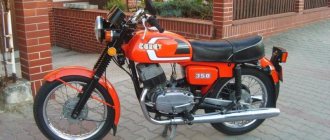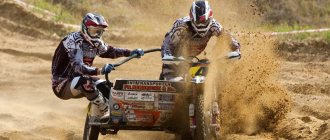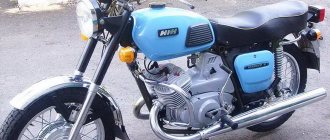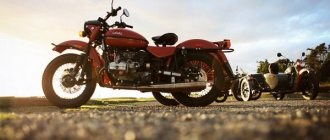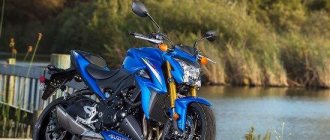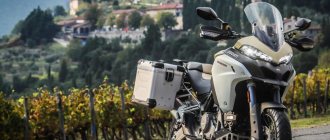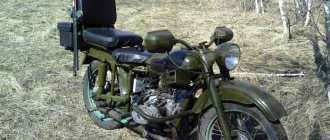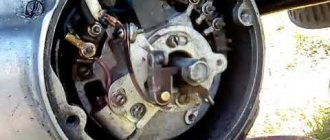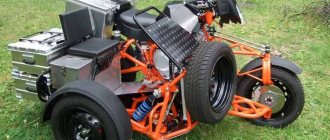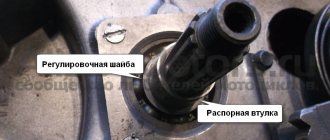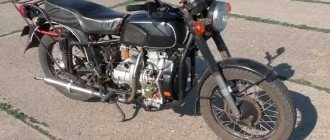Story
Currently, the production of motorcycles has been completely stopped, the plant is being repurposed into a business center, the equipment is being cut and sold for scrap.
Often, many people confuse KMZ Dnepr motorcycle models with IMZ Ural models due to the visual similarity of the designs.
Dnepr is a heavy road motorcycle with a sidecar, produced by KMZ - Kyiv Motorcycle Plant.
Nowadays, all heavy KMZ motorcycles are collectively called “Dnepr”, although the first model to receive its own “Dnepr” K-650 appeared in 1968.
The history of the creation of Dnepr motorcycles has passed a difficult path. After the end of the Great Patriotic War, the country experienced widespread devastation in all spheres of life. Nevertheless, it was necessary to somehow normalize not only the everyday life of citizens, but also the restoration of various production.
The Kiev Motorcycle Plant was one of the first enterprises where normal production was established, with very good prospects for development. It is clear that the first stages of development were very difficult, but the more valuable are the achievements that were shown by the plant’s employees from the very beginning of work and over the years.
Starting from the first stages of its activity, all employees of the Kyiv Motorcycle Plant were busy studying various technical data that could be useful in the production of the first motorcycle in the history of the enterprise - Kievlyanin. The plant itself was formed, thanks to decrees of the Council of People's Commissars No. 2435 - 652 of September 1945, on the basis of the Armored Repair Plant No. 8 on the street. Kagatnaya (currently Khokhlov Family Street). Initially, this model was produced at another plant, but since 1947, all main types of work on the design and manufacture of this motorcycle were carried out at the Kiev Motorcycle Plant.
The year 1947 was notable for the fact that at the Dnepr motorcycle plant they began to develop a new motorcycle on three wheels, simultaneously expanding production workshops aimed at improving the motorcycle industry. In 1949, about a hundred workers and specialists who had previously worked at another production enterprise came to the plant, which was a good help for the implementation of further plans for the manufacture and sale of the M-72 motorcycle. This model had a 4-stroke engine with two cylinders, a power of approximately 22 hp, a volume of 750 cm3 and a speed of 85 km/h. The M-72 was very popular, the rate of its production increased every year, which led to the idea of designing a new type of motorcycle - the M-53. The designer Pozdnyakov K.A. took on the implementation of this task. In addition, work continued to improve existing technologies, develop new seats and improve the braking system.
Since 1953, the Dnepr motorcycle plant finally came under the control of the Ministry of Mechanical Engineering. In 1956, more modernized motorcycles of previous models began to be produced - K-750SM and M-53S. They were produced in fairly wide quantities, at least fifty thousand copies per year, which continued until 1970. In addition, these models participated in various competitions in the GDR, bringing their country several gold models and a team first place. Compared to previous models, power has been increased to 26 hp, while fuel consumption has been reduced.
Another achievement of the Kyiv Motorcycle Plant was the K-750M model with a power of 27 hp. The main features of the new motorcycle are a more powerful generator and improved relay control technology. In addition, additional innovations were provided to make the driving process easier for the driver. In particular, the motorcycle was equipped with a distant view mirror and mudguards for the driver.
In 1967, the plant produced the first batch of the Dnepr motorcycle. It was equipped with a two-cylinder engine with a volume of 650 cm3. In addition, the Dnepr motorcycle could reach a speed of 100 km/h with an engine power of 32 hp. The Dnepr motorcycle engine was of the overhead valve type, at 5000 rpm. In connection with the large production of these motorcycles, which reached 25-26 thousand copies per year, a decision was made to further expand the factory buildings and re-equip them, aimed at the production and production of Dnepr motorcycles. This reconstruction made it possible to maintain the production rates that were necessary for the full sale of these motorcycles.
The year 1971 was notable for the fact that the Kiev plant produced the 500,000th copy of the Dnepr “MT-9” model. Just three years later, it was decided to produce another, more modern model of the Dnepr - “MT-10”. The main difference from the previous model was the presence of new equipment, 12V power, as well as a 200 W generator. In addition, the MT-10 had a 4-stroke engine with a displacement of 650 cm3. When equipped with a sidecar, this motorcycle could reach a speed of 100 km/h. Since 1977, we launched the production of Dnepr motorcycles with increased engine power. They were called that way - MT-10-36, where the last digit indicates the amount of horsepower in the engine. This model was more advanced in terms of comfort and practicality compared to previous models.
Over the entire period of its development, the Kiev Motorcycle Plant has established supplies of its equipment to many countries around the world, including Germany, Holland, Argentina, Cuba, Switzerland and many others. Such an expanded geography of potential buyers led to the launch of new motorcycle models in 1985 - Dnepr 11 and Dnepr 16. The Dnepr 11 motorcycle included a 4-stroke engine with two cylinders. The characteristics of the Dnepr 11 motorcycle were incomplete without mentioning the engine power, which became even greater - 38 hp. In addition, this motorcycle had increased speed indicators - approximately 125 km/h.
Dnepr 16 was first released in the mid-80s of the last century. The MT-10 motorcycle was taken as a basis, but some additional nuances were added. In particular, engine power and speed indicators were increased. Compared to the MT-11, the Dnepr 16 had a lower speed, but it had a sidecar wheel drive. The loss in speed was a minor problem, because these motorcycles were not initially considered racing models, and attention was paid primarily to the versatility and endurance of the entire motorcycle design.
Technical characteristics of the motorcycle Dnepr MT 10
The main technical characteristics of a motorcycle are the engine performance. The engine is a four-stroke engine with two valves and two cylinders, the valves are located at the top. The new product was distinguished by the presence of good traction, which is provided by a volume of 649 cm3. Power was 36 hp. Fuel injection was made possible thanks to two K-301D carburetors.
Electricity was generated using an alternating current generator with a voltage of 12 volts. Moto Dnepr MT 10 had excellent torque, reaching 46 Nm. At maximum acceleration at high power, the bike reached up to 5,800 rpm. The kit included a rechargeable battery; if desired, you can add two batteries.
Engine disadvantages
The Dnepr engine, unlike the Ural engine, has several critical disadvantages:
- The absence of an oil filter in the engine does not ensure cleaning of the oil in the lubrication system;
- Air cooled. Often, such cooling may not be enough to ensure the desired temperature, especially in off-road conditions.
- Prone to overheating. Requires constant monitoring of the oil level, which it likes to consume or “spit out” into the breather;
- In terms of design solutions, the Dnepr engine has a number of shortcomings. The bottom line is that, for unknown reasons, there is no oil filter in the engine; instead there is a so-called centrifuge (centrifugal filter). When centrifugal oil filters are used in car engines, they are installed after coarse oil filters, where they act as fine filters. To put it briefly and clearly, this is a round-shaped part that stands in the engine, it rotates and oil gets into it, there, according to the engineers’ idea and the laws of physics, all the dirt, by inertia, should remain on the walls of this centrifuge and filtered clean oil should be supplied further to the oil system . In practice, some dirt still gets into the lubrication system, shortening the life of the engine. Since the oil channels become clogged, in particular in the crankshaft itself, preventing oil from reaching the crankshaft liners and all this is fraught with critical breakdowns. The Dnepr’s oil system needs improvement, which is what motorcycle owners do on their own, otherwise you’ll just end up with crankshaft liners turning. Therefore, it is recommended to change the engine oil more often;
- Also, according to owners, there are manufacturing defects in the form of a gap between the front engine cover and the crankshaft. This defect leads to the removal of most of the oil into the sump; accordingly, less of it reaches the crankshaft liners;
- The gearbox does not offer excellent smoothness and precision of gear changes. You need to change gears very carefully, otherwise you can simply switch from one speed to another without noticing;
- One cannot fail to note such an important drawback in our time as the relatively high fuel consumption. If you don’t improve the power supply system, it will cost you money, because in the days of the USSR, when fuel really cost a penny, little things like gasoline consumption bothered few people;
- Requires frequent maintenance. Dnepr motorcycle engines require more frequent maintenance compared to car engines. List of work that must be performed during engine maintenance: checking and adjusting valves (thermal clearances), replacing engine oil and oil filter, monitoring the condition of spark plugs;
- Difficulty in maintenance and rather low reliability of the entire system will be the main disadvantages of this engine;
- The pressure reducing valve installed in the pump is located in the crankcase above the oil level; filling it with oil itself is not possible in case of clogging, because the valve does not fit tightly to the seat. Valve cleaning is time-consuming because it also involves disassembling the engine;
- Moreover, it has relatively small output figures: 26 and 32 horsepower, depending on the internal combustion engine model;
- In addition, the engine often suffers from the pins being too tightly seated in the piston, which leads to overheating of the cylinders and heads.
Weaknesses of the Dnepr motorcycle engine
Electronic ignition. Most owners indicated that there were problems with the ignition. The motor runs unevenly and is interrupted. It turned out that it was all due to the electronic ignition, which does not work properly on this motorcycle. Cam ignition is simpler, less complex and therefore more reliable.
Checkpoint. According to some owners, the gearbox is not very reliable.
Causes and solutions to the most common faults occurring in the gearbox:
- Difficult gear shifting - often due to low oil level in the gearbox. Even a small defect can lead to gear shifting problems. Oil is responsible for lubricating all parts of the box, but it should be remembered that after some time it loses its lubricating properties. In this case, change the oil immediately.
- Grinding when shifting gears is usually the result of jamming or wear of the synchronizers - metal rings located on the main shaft of the gearbox, which are supposed to equalize the speed of rotation of the gears. It is the synchronizers that are responsible for the smooth activation of gears. Each gear has its own synchronizer.
- Noisy gearbox operation - the most common cause is worn bearings or gears. This should not be underestimated, as damage to the bearings can even lead to housing rupture.
Pistons. The weakness of the pistons is that the bottom burns out. With 5-10 minutes of engine operation with an ignition timing angle of more than 45°. When overheating, the engine begins to operate with increased noise, loss of power and does not stall when the ignition is turned off (due to overheating, glow ignition occurs). To avoid burning out the pistons, it is necessary to set the advance angle within 32-36° to the top dead center of the piston.
The most common problems with Dnepr motorcycle engines:
The engine does not start.
- The fuel supply system is clogged;
- Spark plugs have failed (carbon deposits, etc.);
- Insufficient compression in the cylinders (valve clearance, rings, etc.);
- The power supply is intermittent;
- Uneven fuel supply;
- Water in the engine or fuel;
- The jets are clogged;
- Faulty spark plugs;
- The integrity of the wiring is broken;
- The air/fuel mixture is too rich.
Engine knock.
- The ignition needs to be adjusted;
- Overheat;
- Problems with pistons and rings (loose fit, etc.).
Weaknesses and disadvantages of the Dnepr motorcycle engine
The engine of the Dnepr motorcycle is a gasoline, carburetor, two-cylinder, four-stroke, with an opposed cylinder arrangement (at an angle of 180°). The designs of engines and gearboxes of the Dnepr and Ural motorcycles are in many ways similar. Among the parts and components of power units, the following are interchangeable: carburetors, compression and oil scraper piston rings, bushings of the upper heads of connecting rods, piston pins with lock rings, valve springs and their plates. Dnieper pistons are larger and to install them in a Ural engine they must be shortened just below the lower oil scraper ring. All parts and assemblies from the clutch specification are interchangeable, with the exception of flywheels.
The gearboxes of both units have unified driven gears, speedometer drive gears, including bearings. Power units or motors and gearboxes are separate and completely interchangeable. The following components are the same in terms of electrical equipment: generator, relay-regulator, breaker with automatic advancer, ignition coil.
